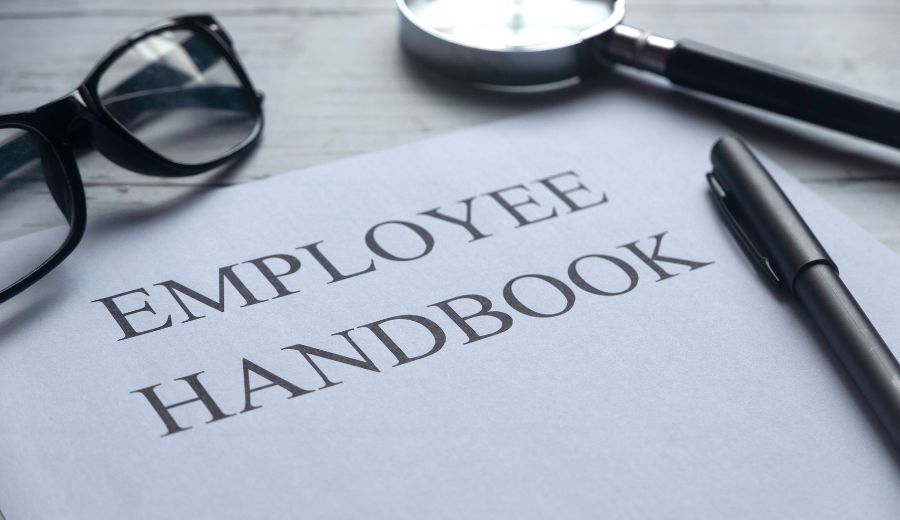Creating a comprehensive employee handbook is essential for nonprofit organizations to establish clear policies and foster a positive work environment that includes workplace safety and employee engagement.
This guide covers the key elements of a nonprofit employee handbook, including its importance, legal requirements, and specific policies such as anti-discrimination, harassment policies, and compensation details that should be included.
It also explains how to review and update the handbook to ensure it complies with current laws, including necessary training compliance and confidentiality procedures.
Whether you are starting from scratch or updating an existing document, this guide provides insights to help you navigate the process, ensuring HR compliance and adherence to nonprofit regulatory standards.
Key Takeaways
What is a Nonprofit Employee Handbook?

A nonprofit employee handbook is an important document that outlines key policies, procedures, and guidelines for nonprofit organizations. It provides a detailed resource that includes the organization's mission statement, values guide, and legal requirements, ensuring employee engagement and compliance with federal, state, and local laws.
A well-organized handbook clarifies employee rights, workplace safety protocols, grievance procedures, and performance management. It also sets the tone for a positive workplace culture that promotes productivity and morale, ultimately reducing turnover rates.
Why is a Nonprofit Employee Handbook Important?
A nonprofit employee handbook is vital for setting clear expectations and creating a positive work environment, thereby boosting employee engagement and morale.
It serves as a key tool for risk management, ensuring that the organization and its staff adhere to important legal requirements such as the Fair Labor Standards Act and Occupational Safety and Health Administration (OSHA) regulations. By outlining workplace policies, procedures, and employee rights, it helps to prevent legal issues.
A well-organized handbook shapes workplace culture by promoting shared values, fostering collaboration, and respecting employees. Don't miss out on improving morale and strengthening commitment to the mission, contributing to the nonprofit's success!
What are the Legal Requirements for a Nonprofit Employee Handbook?

Creating a nonprofit employee handbook requires following legal guidelines to ensure compliance with federal, state, and local laws, which are crucial for protecting the organization and its staff.
Nonprofits need to include specific policies on workplace safety, anti-discrimination, harassment policies, and confidentiality procedures to meet legal standards like the Fair Labor Standards Act and OSHA regulations. These requirements protect employee rights and help establish a risk management framework that promotes a positive work environment and culture.
What are the Federal Laws that Apply to Nonprofits?
Nonprofit organizations must follow several federal laws that impact their employee handbooks and operations.
The Fair Labor Standards Act sets rules for minimum wage and overtime, ensuring fair pay for staff. The Americans with Disabilities Act prevents discrimination against people with disabilities and requires reasonable workplace accommodations. The Age Discrimination in Employment Act protects workers over 40 from age discrimination, promoting inclusivity.
These regulations safeguard employee rights, ensure workplace safety, and shape comprehensive employee handbooks that help both management and staff understand their rights and responsibilities.
What are the State Laws that Apply to Nonprofits?
Nonprofits must adhere to both federal and state laws related to employee rights, workplace safety, and wages when creating an employee handbook.
These laws include minimum wage standards, overtime pay, and the requirement to maintain accurate records, including I-9 forms and other recordkeeping mandates for compliance. Employee rights, such as anti-discrimination measures and family leave policies, vary by state, so it's essential to tailor policies to local laws.
Understanding Nonprofit Employee Handbooks
Keeping up with regulatory changes is necessary as it impacts organizational liability and employee welfare. Understanding these details helps nonprofits create a fair workplace, improving employee morale and retention while ensuring legal compliance.
What Policies Should be Included in a Nonprofit Employee Handbook?

A complete nonprofit employee handbook should contain essential policies tailored to the unique needs of nonprofit organizations, promoting a safe and compliant workplace.
Here are important policies to include:
By detailing these policies, nonprofits can enhance employee engagement, ensure legal compliance, and foster a supportive workplace culture, which is essential for retaining talent.
Equal Employment Opportunity Policy
A robust Equal Employment Opportunity (EEO) policy is vital for nonprofits because it ensures fair treatment and prohibits discrimination based on race, gender, age, disability, and other protected characteristics.
This policy defines the organization's legal duties while promoting a culture of inclusivity and respect among employees. By implementing strong anti-discrimination practices, it provides a framework that encourages employee engagement and collaboration.
It allows individuals to be themselves at work, knowing their contributions are valued, regardless of personal differences. This approach boosts employee morale, attracts a diverse range of talent, and enhances organizational performance, aligning with the nonprofit's mission and values.
Anti-Discrimination and Harassment Policy
A strong anti-discrimination and harassment policy is essential for nonprofits to create a respectful and safe work environment, upholding employee rights and workplace integrity.
This policy fosters an inclusive culture where everyone understands their rights and responsibilities. Nonprofits should provide clear procedures for reporting discrimination or harassment, offering several reporting methods without fear of retaliation.
Training programs can help staff recognize inappropriate behavior and respond effectively. By implementing these protocols, nonprofits show their commitment to workplace safety, training compliance, and HR compliance, thereby improving overall morale and productivity.
Code of Conduct and Ethics Policy
A Code of Conduct and Ethics Policy is crucial for nonprofit organizations. It guides employee behavior and provides a framework for ethical decision-making while clarifying the organization's values and aligning all team members with its mission and vision.
This policy promotes accountability, respect, and transparency, boosting workplace morale and encouraging collaboration. Clear reporting procedures for unethical practices enable individuals to voice concerns without fear, strengthening trust within the organization. A well-implemented Code of Conduct enhances the nonprofit's reputation, attracting supporters and volunteers who share its ethical standards.
Compensation and Benefits Policy
A clear Compensation and Benefits Policy is essential for nonprofit organizations, as it details pay, health insurance, retirement plans, and promotes transparency among employees.
This policy defines various pay structures and ensures fairness throughout the organization. Providing benefits like paid time off and wellness programs addresses employee needs and boosts morale.
When employees feel valued and secure, their engagement and productivity increase, leading to greater loyalty. Well-structured compensation practices are crucial in retaining talent within the nonprofit sector, as satisfied employees are more likely to remain committed to the organization's mission.
Leave and Time Off Policies
Establishing clear leave and time-off policies is crucial for nonprofit organizations to ensure employees understand their rights regarding sick leave, vacation days, and other paid time off. These policies promote transparency and trust and help organizations comply with labor laws.
Nonprofits should detail the types of leave available, such as personal leave, bereavement leave, and family medical leave, to support employee well-being. Prioritizing these policies demonstrates a commitment to employee welfare and helps create a supportive and engaged workforce.
Understanding legal requirements is vital, as organizations must adhere to the Fair Labor Standards Act, which ensures fair pay, and the Family Medical Leave Act, which protects employees' rights to take leave for family and medical reasons. Clear policies help improve employee morale and retention, aligning with the mission-driven focus of nonprofits.
Confidentiality and Non-Disclosure Policy
A Confidentiality and Non-Disclosure Policy is essential for nonprofit organizations to protect sensitive information. It ensures employees understand data security and confidentiality procedures.
This policy provides a clear framework for how staff should handle and share confidential information. It helps prevent unauthorized access and reassures stakeholders that their personal and financial data is managed with care, ensuring data security.
In terms of nonprofit compliance, a clear confidentiality agreement builds trust with donors and beneficiaries while reducing the risk of legal issues from data breaches. It encourages employees to maintain integrity and responsibility, reinforcing the organization's commitment to protecting sensitive information. This is crucial for HR compliance and maintaining a positive work environment.
Technology and Social Media Policy
A Technology and Social Media Policy guides employees on using technology and social media responsibly, balancing the organization’s needs with employee rights while ensuring data security.
As digital communication increasingly shapes workplace culture, these policies set clear online behavior guidelines and help create a professional environment that emphasizes accountability and respect.
By specifying best practices, such as proper conduct on social platforms and addressing data privacy, confidentiality procedures, and workplace safety, organizations can mitigate the risk of harm to their reputation. Violations of these guidelines can lead to disciplinary action or legal consequences, underscoring the need for compliance.
A well-structured policy acts as a protective framework, supporting employees while safeguarding the nonprofit's mission and values.
How Should a Nonprofit Employee Handbook be Reviewed and Updated?

Regularly reviewing and updating a nonprofit employee handbook is crucial to stay compliant with changing legal requirements, align with organizational policies, and address the evolving needs of the workforce, ensuring HR compliance.
Who Should be Involved in the Review Process?
Key stakeholders such as HR professionals, the Executive Director, and legal advisors should be involved in reviewing a nonprofit employee handbook. This ensures thorough oversight and compliance with legal and organizational standards, including federal regulations and state laws.
This collaboration helps build a solid framework that protects employee rights and aligns with the organization’s mission and values. HR professionals focus on necessary updates and legal compliance, while management offers insights into operational needs and workplace culture. Legal experts address potential liabilities and ensure policy adherence to industry regulations, including the Fair Labor Standards Act and other wage laws.
Open communication and mutual respect among these groups are crucial for creating a handbook that effectively guides staff and upholds the nonprofit’s commitment to ethical governance.
When Should the Handbook be Reviewed?
A nonprofit employee handbook should be reviewed regularly, ideally every year, or whenever there are significant changes in legal regulations, organizational policies, or workplace culture.
Don't wait for issues to arise; review your handbook annually to maintain compliance with current laws and best practices. Changes in labor laws, including overtime pay and minimum wage laws, and nonprofit HR regulations may require updates to reflect new roles and responsibilities.
Regular reviews also address emerging issues like remote work policies, diversity and inclusion strategies, and training compliance, which are increasingly important in today’s work environment. Keeping the handbook current promotes a transparent workplace culture.
What are the Steps for Updating the Handbook?
Updating a nonprofit employee handbook should be methodical and follow several steps, such as gathering feedback from employees, reviewing legal guidelines, and aligning with the organization's mission statement and values.
Involving employees in this process is important. It builds a sense of ownership and community, enhancing employee engagement. Start by having the leadership team conduct surveys or focus groups to gather staff opinions and concerns about current policies.
Review state and federal labor laws thoroughly to ensure compliance and reflect best practices in nonprofit operations, including employment policies and workplace safety protocols. At the same time, align the handbook with the organization’s mission and values so that employees understand their rights and responsibilities and feel motivated by the organization’s core principles.
Maintain transparency and communication throughout this process. This builds trust, enhances employee morale, and promotes a healthy organizational culture.
Common Questions About Nonprofit Employee Handbooks
What is an Employee Handbook for Nonprofits?
An employee handbook for nonprofits is a document that outlines the policies, procedures, and expectations for employees within a nonprofit organization. It serves as a guide for employees to understand their rights, responsibilities, benefits offered, and compensation details while working for the nonprofit.
Why is it important to review and update the nonprofit employee handbook?
Reviewing and updating the nonprofit employee handbook ensures that the organization's policies and procedures comply with current laws and regulations. It also provides clear and consistent guidelines for employees, promoting a positive work environment.
What legal compliance considerations must be included in a nonprofit employee handbook?
Legal compliance considerations in a nonprofit employee handbook must include equal employment opportunity policies, anti-discrimination and harassment policies, workplace safety policies, confidentiality agreements, and recordkeeping requirements. It should also include information on federal and state laws that pertain to the organization, such as the Age Discrimination in Employment Act and the Americans with Disabilities Act.
Can a nonprofit employee handbook be a legally binding contract?
A nonprofit employee handbook can be a legally binding contract if it explicitly states so and the employee acknowledges it.
What happens if a nonprofit organization fails to review and update their employee handbook?
If a nonprofit organization fails to review and update their employee handbook, they risk violating current laws and regulations. This could result in legal consequences and damage the organization's reputation. It is essential for organizations to regularly review and update their employee handbook to ensure compliance.
Are there any specific laws or regulations that nonprofit organizations should be aware of when creating an employee handbook?
Nonprofits should know federal and state employment laws, like the Fair Labor Standards Act and the Family and Medical Leave Act. They should also be familiar with any laws specific to their industry or location, such as minimum wage laws or state-specific anti-discrimination laws. Compliance audits and IRS regulations are crucial for maintaining tax-exempt status.

